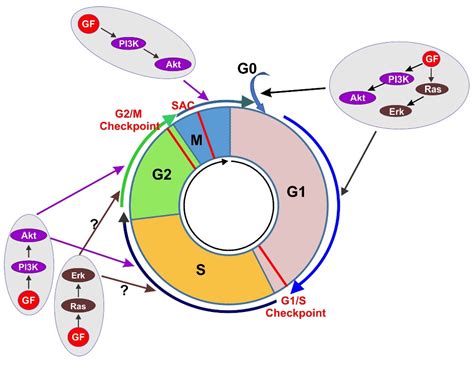In the complex world of cell division, the G2 checkpoint acts as a meticulous gatekeeper, ensuring the integrity of our genetic material and preventing the uncontrolled proliferation of cells. This critical surveillance mechanism plays a pivotal role in maintaining genomic stability and preventing the development of diseases such as cancer.

Understanding the Cell Cycle
The cell cycle is a highly regulated process that ensures the orderly division of cells into two daughter cells. It consists of four distinct phases:
- G1 phase: The cell grows, synthesizes proteins, and prepares for DNA replication.
- S phase: DNA replication occurs, resulting in the duplication of genetic material.
- G2 phase: The cell checks for DNA damage and prepares for mitosis.
- M phase: Mitosis occurs, dividing the cell into two daughter cells.
The G2 Checkpoint: A Vigilant Supervisor
The G2 checkpoint, also known as the G2/M checkpoint, is a crucial surveillance mechanism that occurs at the end of the G2 phase. It prevents the cell cycle from progressing into mitosis until several essential conditions are met:
- DNA Damage Repair: The G2 checkpoint provides an opportunity for DNA repair mechanisms to fix any damage incurred during DNA replication. If DNA damage is detected, the checkpoint halts the cell cycle to allow for its repair.
- Cell Size and Growth: The G2 checkpoint ensures that the cell has attained the appropriate size and growth to support successful mitosis.
- Nucleotide Synthesis: The G2 checkpoint verifies that the cell has synthesized sufficient nucleotides, the building blocks of DNA, to support the accurate duplication of genetic material during mitosis.
Consequences of Bypassing the G2 Checkpoint
Failure to adhere to the G2 checkpoint can have dire consequences:
- Aneuploidy: Bypassing the G2 checkpoint can lead to aneuploidy, a condition in which cells have an abnormal number of chromosomes. This abnormality can severely impair cell function and lead to developmental abnormalities and cancer.
- Genomic Instability: Circumventing the G2 checkpoint can promote genomic instability, a state in which the genome undergoes frequent changes and rearrangements. This genomic instability increases the risk of developing diseases such as cancer.
- Cancer Development: The G2 checkpoint acts as a tumor suppressor mechanism. By preventing the proliferation of cells with damaged DNA or incomplete growth, it helps prevent the development of cancer. By evading the G2 checkpoint, cells with defective genes can undergo uncontrolled proliferation, leading to tumor formation.
Importance of the G2 Checkpoint
The G2 checkpoint is essential for maintaining genomic stability and preventing cancer development. It plays a critical role in ensuring that:
- Cells only enter mitosis when they are fully prepared and have repaired any DNA damage.
- Cells have sufficient size and resources to support successful cell division.
- Cells have adequate nucleotides to accurately duplicate genetic material during mitosis.
Strategies to Enhance G2 Checkpoint Function
Several strategies can help enhance G2 checkpoint function and reduce the risk of cell cycle errors and disease development:
- Pharmacological Interventions: Certain drugs can stimulate or inhibit the G2 checkpoint. These drugs can be used to treat diseases such as cancer by preventing the proliferation of cancerous cells.
- Lifestyle Modifications: Maintaining a healthy lifestyle, including regular exercise, a balanced diet, and adequate sleep, can improve cellular health and enhance the efficiency of the G2 checkpoint.
- Genetic Counseling: Individuals with a family history of cancer or genetic predispositions to genomic instability may benefit from genetic counseling. Early detection and preventive measures can help mitigate the risks associated with G2 checkpoint dysfunction.
Case Study: G2 Checkpoint in Cancer Treatment
In the field of cancer treatment, the G2 checkpoint has emerged as a promising target for therapeutic interventions. Researchers have developed drugs that specifically inhibit the G2 checkpoint, forcing cells with damaged DNA to enter mitosis. This forces the cells to attempt division with defective genetic material, leading to cell death.
This approach has shown promising results in preclinical studies and is currently being investigated in clinical trials. By targeting the G2 checkpoint, researchers hope to develop more effective and targeted treatments for various types of cancer.
Tables
Table 1: Cell Cycle Phases and Duration
| Phase | Duration |
|---|---|
| G1 | 10-12 hours |
| S | 6-8 hours |
| G2 | 4-6 hours |
| M | 1 hour |
Table 2: Consequences of Bypassing the G2 Checkpoint
| Consequence | Impact |
|---|---|
| Aneuploidy | Abnormal number of chromosomes |
| Genomic Instability | Frequent genome changes |
| Cancer Development | Uncontrolled cell proliferation |
Table 3: Strategies to Enhance G2 Checkpoint Function
| Strategy | Mechanism |
|---|---|
| Pharmacological Interventions | Stimulate or inhibit the G2 checkpoint |
| Lifestyle Modifications | Improve cellular health and checkpoint efficiency |
| Genetic Counseling | Identify individuals at risk for G2 checkpoint dysfunction |
Table 4: Role of the G2 Checkpoint in Cancer Treatment
| Approach | Mechanism |
|---|---|
| G2 Checkpoint Inhibitors | Force cells with damaged DNA to enter mitosis |
| Targeted Cancer Therapies | Develop more effective and individualized treatments |
